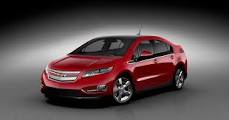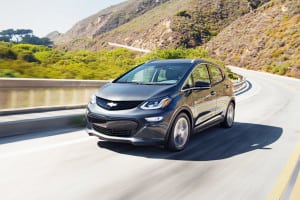By Kennedy Maize
Washington, D.C., January 29, 2012 — Detroit is back and the year 2012 looks promising for U.S. automakers. But unlike the hype of early last year, the color that most of the auto industry is seeing in its dreams for 2012 isn’t green, it’s black. That’s in black ink, which has firmly replaced the flowing red of the recent recession years.
The big three of the U.S. — counting Fiat-owned Chrysler — all reported profits for 2011 and 2012 looks even better, according to Associated Press auto writer Dee-Ann Durbin. Overall, U.S. auto sales totaled 12.8 million in 2011, up 10% over 2010 and 22% over the 2009 figures.
Chrysler, which went through formal bankruptcy in 2009, turned in a particularly strong year. It saw its sales up 26% for 2011, driven largely by sales of the Jeep Grand Cherokee and the Chrysler 200 sedan. Durbin noted that Chrysler ousted Honda as number 4 in the U.S. market share top 10.
Honda and Toyota suffered badly in 2011 from the March 11, 2011 Japanese earthquake and tsunami that disrupted supply chains throughout the island nation.
For 2012, forecaster and online car seller TrueCar.com is predicting U.S. sales of 14 million cars and light trucks.
But while 2011 was a good year for cars, it wasn’t because of the over-hyped and under-performing electric segment of the industry offerings. While GM execs such as Bob Lutz long ago said their future was tied to EVs — and the Obama administration, which wanted to, believed them — GM’s Chevy Volt underwhelmed ordinary consumers. Sales, never very good at best, went south when GM and the government reported that Volt batteries were spontaneously combusting. GM’s Volt sales target for 2011 was 10,000 units, which it won’t hit until sometime this year. By most accounts, GM sold around 7,000 Volts in 2011.
When it comes to Volt sales, the Cato Institute’s Pat Michaels pointed out recently that a lot of those sales have been to governments and fleet buyers, with proportionally fewer to average (or above average when it comes to income) buyers. Michaels deconstructed the Volt’s December sales figures in a recent op-ed in the New York Post. GM sold 1529 Volts in the final month of the year. More than a third were to fleet buyers, but not, Michaels noted, the traditional fleet buyers such as Hertz and Avis. Rather, they were large companies that appear to be trying to make a political statement, such as General Electric. Then there are the Volts bought by taxpayers. New York City bought 50, on the taxpayers’ tab, not that of billionaire mayor Michael Bloomberg. Deland, Fla., has bought five Volts, using Department of Energy stimulus grant money.
Michaels wrote that “until GM is transparent and forthcoming about how many (or how few) Volts are selling to private individuals, we aren’t going to know.” But the signs, he said, are “ominous” about the viability of the Volt. Even Bob Lutz, “the car guy’s car guy,” is skeptical about electric cars as everyday vehicles. He told CarTalk.com that “people buy cars based on style. No one will buy an electric car that looks like a Dorkmobile. If it’s beautiful and it does what people say it’s going to do, they’ll pay the price.”
Lutz is particularly skeptical of the market appeal of Nissan’s battery-only Leaf, which some early adopters have gobbled up. The Leaf reportedly sold 9600 cars in 2011, beating the Volt. “I’m a little bit less enamored of the Nissan Leaf,” he said,” because it has all the normal electric car limitations—on a good day it has a range of 80 miles, which means that a lot of commuters will experience what they call ‘range anxiety.’”
A journey by Stephen Smith, head of the South Alliance for Clean Energy, demonstrates the limits of the Leaf. Smith drove his new Leaf on a 180-mile trip from Knoxville to Nashville to visit family over the holidays. The trip required four stops at Cracker Barrel restaurants along the way (which feature “fast” chargers which will replenish the car’s battery in only 30 minutes). The longest distance between charges was 51 miles.
Adding up all the electrics — all flavors including hybrids, plug-ins, and pure plays — notes a Reuters account, and they about 2% of U.S. car sales last year. Take out the now-conventional hybrids and the total is less than 20,000 cars sold during the year. Says Auto Trends Consulting analyst Joe Phillippi, “I’d say they failed.”
The problem with today’s electric cars is the same that doomed the technology in the early 20th Century: the battery. There still aren’t batteries available that come close to matching the power-to-weight-to-price equation of the internal combustion engine. The Fisker Karma is a fine example of the problem with current battery technology. The car, a high-end plug-in hybrid, has had so many problems it ought to be named the Bad Karma. The cost of the batteries has driven the base price of the car to $102,000, up $20,000 from the original plan for the Karma.
Energy secretary Steven Chu has proclaimed that he sees the price of an EV battery that goes for $12,000 today falling to $3,600 by 2015. He said the administration would reach its goal of 1 million electric vehicles on the road in the U.S. by the same time. Those claims drew considerable skepticism when Chu made them at the Detroit auto show in January. Michigan columnist Henry Payne scoffed, “This from the same man who flushed $500 million in taxpayer dollars down the Solyndra drain because he got solar panel prices wrong.”
Ironically, two weeks after Chu’s bold prediction, lithium ion battery developer Ener1 filed for Chapter 11 bankruptcy, despite a $118.5 million DOE stimulus grant. Market research firm Citron cast doubt on how well DOE exercised due diligence before doling out funds to Ener1. The research firm said: “So here is the story in a nutshell (or the trunk of a Prius). It is Citron’s opinion that Ener1 is just a corporate shell company with a long history of failed businesses based on exaggerated promises. Management has tried everything from video games to visualization software to set top boxes for television. All of these businesses have failed — miniscule revenues and never a penny of profit delivered to investors. They purchased Delphi’s years-old attempt to get a lithium battery business going, and got a sublease on a manufacturing plant in Indianapolis. Since then we haven’t seen a single sign of a viable business.”
For me, long a skeptic of electric cars and a fan of diesel technology, the future doesn’t look promising for the administration’s push for electric vehicles. But it does look very good for the luxury liners. Rolls Royce (owned by BMW) had a banner year in 2011, with sales up 31% (to a Volt-like total of 3500 cars). The Wall Street Journal reported from the Frankfurt auto show, “Demand for luxury sports-utility vehicles is booming worldwide, defying concerns that rising fuel prices and environmental concerns would inevitably crimp demand in a lucrative segment for top manufacturers.”
Or as Michigan’s Henry Payne said after Chu and his crew left the press week tour of Cobo Hall in Detroit before the opening of the auto show, “As Chu and his entourage boarded a plane back to Washington, automakers were already busy preparing the show floor for public consumption next week. Chu’s electrics will move to the background as automakers flog the popular SUVs that have once again captured over 50 percent of the U.S. market.”
The author owns a 2004 Toyota Highlander SUV and a 2011 Chevy Express full-size van, both powered by conventional gasoline internal combustion engines. He lusts for a new VW Toureg diesel.









